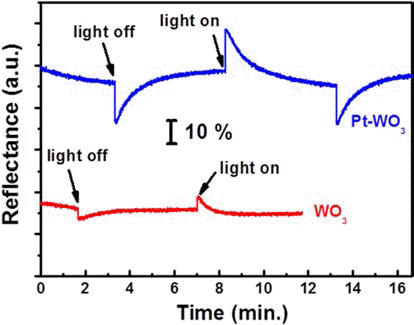Search
- Page Path
- HOME > Search
- [Korean]
- Effects of Heat Treatment and Viologen Incorporation on Electrochromic Properties of TiO2 Nanotubes
- Hyeongcheol Cha, Yoon-Chae Nah
- J Korean Powder Metall Inst. 2016;23(2):102-107. Published online April 1, 2016
- DOI: https://doi.org/10.4150/KPMI.2016.23.2.102

- 675 View
- 3 Download
- 1 Citations
-
 Abstract
Abstract
 PDF
PDF We demonstrate the electrochromic properties of TiO2 nanotubes prepared by an anodization process and investigate the effects of heat treatment and viologen incorporation on them. The morphology and crystal structure of anodized TiO2 nanotubes are investigated by scanning electron microscopy and X-ray diffraction. As-formed TiO2 nanotubes have straight tubular layers with an amorphous structure. As the annealing temperature increases, the anodized TiO2 nanotubes are converted to the anatase and rutile phases with some cracks on the tube surface and irregular morphology. Electrochemical results reveal that amorphous TiO2 nanotubes annealed at 150°C have the largest oxidation/ reduction current, which leads to the best electrochromic performance during the coloring/bleaching process. Viologenanchored TiO2 nanotubes show superior electrochromic properties compared to pristine TiO2 nanotubes, which indicates that the incorporation of a viologen can be an effective way to enhance the electrochromic properties of TiO2 nanotubes.
-
Citations
Citations to this article as recorded by- Fabrication of patterned TiO2 nanotube layers utilizing a 3D printer platform and their electrochromic properties
Kwang-Mo Kang, Seok-Han Lee, Sang-Youn Kim, Yoon-Chae Nah
Electrochemistry Communications.2024; 169: 107833. CrossRef
- Fabrication of patterned TiO2 nanotube layers utilizing a 3D printer platform and their electrochromic properties
- [Korean]
- Fabrication of Photoelectrochromic Devices Composed of Anodized TiO2 and WO3 Nanostructures
- Sanghoon Lee, Hyeongcheol Cha, Yoon-Chae Nah
- J Korean Powder Metall Inst. 2015;22(5):326-330. Published online October 1, 2015
- DOI: https://doi.org/10.4150/KPMI.2015.22.5.326

- 513 View
- 3 Download
- 3 Citations
-
 Abstract
Abstract
 PDF
PDF In this study, we demonstrate the photoelectrochromic devices composed of TiO2 and WO3 nanostructures prepared by anodization method. The morphology and the crystal structure of anodized TiO2 nanotubes and WO3 nanoporous layers are investigated by SEM and XRD. To fabricate a transparent photoelectrode on FTO substrate, a TiO2 nanotube membrane, which has been detached from Ti substrate, is transferred to FTO substrate and annealed at 450°C for 1 hr. The photoelectrode of TiO2 nanotube and the counter electrode of WO3 nanoporous layer are assembled and the inner space is filled with a liquid electrolyte containing 0.5 M LiI and 5 mM I2 as a redox mediator. The properties of the photoelectrochromic devices is investigated and Pt-WO3 electrode system shows better electrochromic performance compared toWO3 electrode.
-
Citations
Citations to this article as recorded by- Synthesis and characterization of nitrogen-doped TiO 2 coatings on reduced graphene oxide for enhancing the visible light photocatalytic activity
Yifan Zhang, Hye Mee Yang, Soo-Jin Park
Current Applied Physics.2018; 18(2): 163. CrossRef - Photocatalytic and Adsorption Properties of WO3 Nanorods Prepared by Hydrothermal Synthesis
Su-Yeol Yu, Chunghee Nam
Journal of Korean Powder Metallurgy Institute.2017; 24(6): 483. CrossRef - Synthesis and Photo Catalytic Activity of 10 wt%, 20 wt%Li-TiO2 Composite Powders
Hyeong-Chul Kim, Jae-Kil Han
Journal of Korean Powder Metallurgy Institute.2016; 23(1): 33. CrossRef
- Synthesis and characterization of nitrogen-doped TiO 2 coatings on reduced graphene oxide for enhancing the visible light photocatalytic activity
- [Korean]
- Shape Control of Anodic Aluminum Oxide and Effect as Support of Silicon Powder Electrode
- Ju-Seok Song, Jong-Keun Ha, Yoo-Young Kim, Dong-Kyu Park, In-Shup Ahn, Jou-Hyeon Ahn, Kwon-Koo Cho
- J Korean Powder Metall Inst. 2015;22(4):240-246. Published online August 1, 2015
- DOI: https://doi.org/10.4150/KPMI.2015.22.4.240

- 551 View
- 1 Download
- 1 Citations
-
 Abstract
Abstract
 PDF
PDF Anodic aluminum oxide (AAO) has been widely used for the development and fabrication of nano-powder with various morphologies such as particle, wire, rod, and tube. So far, many researchers have reported about shape control and fabrication of AAO films. However, they have reported on the shape control with different diameter and length of anodic aluminum oxide mainly. We present a combined mild-hard (or hard-mild) anodization to prepare shape-controlled AAO films. Two main parameters which are combination mild-hard (or hard-mild) anodization and run-time of voltage control are applied in this work. The voltages of mild and hard anodization are respectively 40 and 80 V. Anodization was conducted on the aluminum sheet in 0.3 mole oxalic acid at 4°C. AAO films with morphologies of varying interpore distance, branch-shaped pore, diameter-modulated pore and long funnel-shaped pore were fabricated. Those shapes will be able to apply to fabricate novel nano-materials with potential application which is especially a support to prevent volume expansion of inserted active materials, such as metal silicon or tin powder, in lithium ion battery. The silicon powder electrode using an AAO as a support shows outstanding cycle performance as 1003 mAh/g up to 200 cycles.
-
Citations
Citations to this article as recorded by- Nano silicon encapsulated in modified copper as an anode for high performance lithium ion battery
Jong-Keun Ha, Anupriya K. Haridas, Gyu-Bong Cho, Hyo-Jun Ahn, Jou-Hyeon Ahn, Kwon-Koo Cho
Applied Surface Science.2019; 481: 307. CrossRef
- Nano silicon encapsulated in modified copper as an anode for high performance lithium ion battery
TOP
 KPMI
KPMI


 First
First Prev
Prev


